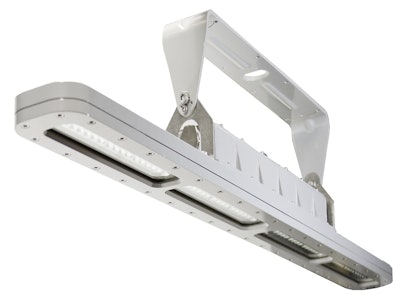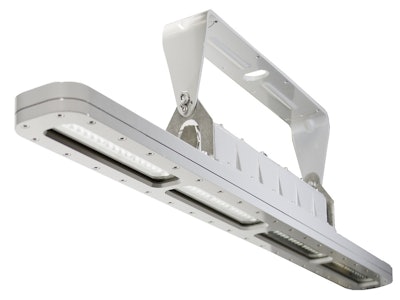
LED fixtures are quickly becoming the new standard for industrial lighting, far outperforming conventional fixtures in energy efficiency, low cost of ownership and durability to withstand even the harshest conditions, including dirty power, high-vibration, extreme temperatures and hazardous or volatile environments.
While the solid-state design of LEDs gives them an advantage compared to traditional lighting sources (incandescent, fluorescent and H.I.D.), not all LED fixtures are created equal. A number of critical factors combine to determine overall fixture longevity and reliability in an industrial environment, including efficient power conversion, effective thermal management, an integrated design and a tightly controlled, well-managed manufacturing and quality control process. With the right combination of design and manufacturing, there’s no question that the best LED fixtures on the market can last in excess of 100,000 hours, saving companies hundreds of thousands of dollars each year. Choose a fixture with active thermal protection, but also ask the manufacturer to share their thermal roll-off strategy to ensure the best overall performance and long fixture life.But, what exactly separates a fixture that can actually go the distance from one that looks good on paper? When evaluating suppliers, use this checklist to make sure the product you choose is designed, built, tested — and guaranteed — to stand up to the rigors of industrial use.

- Verify LM-80 and TM-21 reports. These standards ensure that the LEDs used in the fixture are tested and verified to last as promised for life of the 5, 7 or 10-year warranty. Use a heat gun to measure temperature of objects nearby the installation site, such a support beam, to estimate ambient air temperature. If the average temperature exceeds 25°C, request lumen data for higher ambient conditions.
- Clarify thermal protection specs. Many sub-standard LED fixtures are prone to failure if they unexpectedly overheat, resulting in a much shorter life or even a potential safety hazard. More sophisticated LED luminaires are designed with built-in thermal protection that reduces power (and lumen output accordingly) to protect the fixture. However, in an effort to raise the thermal roll-off point, some manufacturers sacrifice fixture reliability in other areas, for example, triggering the roll-off point at the luminaire’s maximum rated ambient temperature. That means high temperatures approaching that point put tremendous strain on the integral components, weakening the fixture prematurely. Choose a fixture with thermal protection, but also ask the manufacturer to clarify the specifications to ensure the best overall performance.
- Look for a purpose-built, integrated design. Many manufacturers simply assemble low-quality, off-the-shelf components which aren’t designed for lighting applications, let alone the harsh conditions inside a heavy industrial facility. Fixtures intended for high-temperature or volatile conditions require specialized, high-temperature capacitors and magnetics and high-voltage semiconductors that can withstand the rigors of the environment. Steer clear of manufacturers that use a piecemeal, modular approach to building fixtures. Instead, for a guaranteed more reliable fixture, choose a supplier that uses a closed-loop, integrated design process where each purpose-built component is specifically configured to work together for optimal thermal, mechanical, optical and electrical performance. One that engages in routine prognostic and health management to continuously improve in an effort to approach zero failure is even better.
- Insist on Accelerated Life Testing (ALT). LED manufacturers that merely assemble stock components can perform only standard design verification and must rely on their component suppliers for the performance data. But, this pertains only to the individual parts and says nothing about how the components will perform once they’re assembled together into the fixture. Integrated design manufacturers employ Accelerated Life Testing (ALT) during the design process to simulate real-world usage over a 10-plus year life-span. This rigorous product testing and performance evaluation during the design phase verifies the fully-assembled product can deliver the long-life performance as promised before production even begins.
- Ask for Highly Accelerated Stress Screening (HASS) during production. Most manufacturers test their products with a 4 to 6-hour burn-in off the manufacturing line. Some far exceed that standard using a much more rigorous process called Highly Accelerated Stress Screening (HASS) during production, which includes extended burn-in under high-stress conditions. This type of screening process subjects the fixture to conditions that are likely far worse than any that will be encountered in the real world, but ensures the fixture can withstand the worst case scenario.
- Specify all-around durability. While some manufacturers tout the durability of their delicate electronics, the rest of the fixture must be up to the challenge as well, otherwise you may be overpaying for top-notch electronics in a sub-par chassis. The most reliable LED fixtures are built top-to-bottom with the rugged components including everything from the power supply and surge protection to the paint finish, optical reflectors, lenses, seals, mounting accessories and everything in between. Keep in mind that products designed for indoor or light industrial may not match the reliability of the LEDs.
- Demand a written full-system warranty. It only takes a single weak link to result in a failure. Because the lifetime performance of the fixture depends on so many different components and how they’re assembled, a fixture warranty should cover ALL of those components. While many LED luminaire manufacturers claim to offer 5 or 7-year fixture warranties, a closer look at the fine print often reveals that the power supply isn’t included. That’s like buying a new car with a warranty that covers everything but the engine. Choose a supplier that offers a true bumper-to-bumper warranty, protecting the entire fixture — and your entire investment. Even better, look for manufacturers that have already proven their products through their first warranty cycle.
With the accelerated adoption and demand for LED technology in industrial applications, the industry has seen rapid growth in the number of manufacturers, products and claims on the market. While certainly this is good for customers, offering a wider range of choice in suppliers, form factors and options, it also means LED buyers must carefully cut through the marketing hype to ensure they’re getting only the most dependable, robust and economical products to meet their needs.
Remember the commercial adage, “Caveat Emptor,” or “let the buyer beware.” Most manufacturers offer “limited” warranties. It is your right as a consumer to know what those “limitations” are. Does the warranty include the power supply? Does the manufacturer send you a new fixture if it fails? Or, do they intend to ship you parts and expect you to take the fixture down, make repairs on a work-bench and then re-hang the fixture, all at your expense? When do they consider a fixture a failure, after 10 – 15 percent of the LEDs have failed? Demand a written warranty, read it and understand its limitations.
Rizwan Ahmad is VP of Engineering and Technology at Dialight.























